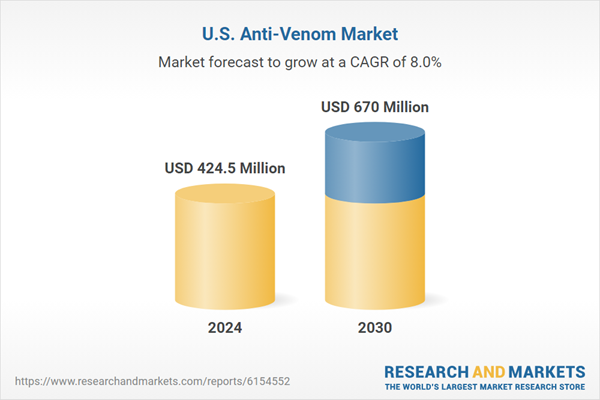The U.S. anti-venom market size was estimated at USD 424.5 million in 2024 and is projected to reach USD 670.0 million by 2030, growing at a CAGR of 8.0% from 2025 to 2030. The market is expanding due to the rising incidence of venomous bites and stings, especially from snakes and insects.
Increased human interaction with venomous species is fueled by urbanization, deforestation, and climate change, which have impacted the habitats of these animals and brought them closer to populated areas. This trend has heightened the need for effective anti-venom treatments to reduce fatalities and long-term health complications associated with envenomation, driving the U.S. anti-venom industry.
Advancements in biotechnology significantly contribute to market growth. Innovations such as monoclonal antibody-based anti-venoms and recombinant DNA technologies have resulted in the development of more potent, safer, and targeted therapies. These improvements enhance treatment outcomes and help reduce production costs, making anti-venoms more accessible. The continuous research and development efforts by pharmaceutical companies and research institutions, particularly in the U.S., foster innovation and the introduction of advanced anti-venom products tailored to specific venom types.
The U.S. market benefits from a robust healthcare system that facilitates rapid access to anti-venom treatments in emergency settings. The prevalence of outdoor recreational activities and expanding urban development into wildlife habitats increases the likelihood of encounters with venomous species, thereby driving market demand. Moreover, the presence of key industry players and ongoing government support for pharmaceutical innovation strengthen the market’s growth prospects.
This product will be delivered within 2 business days.
Increased human interaction with venomous species is fueled by urbanization, deforestation, and climate change, which have impacted the habitats of these animals and brought them closer to populated areas. This trend has heightened the need for effective anti-venom treatments to reduce fatalities and long-term health complications associated with envenomation, driving the U.S. anti-venom industry.
Advancements in biotechnology significantly contribute to market growth. Innovations such as monoclonal antibody-based anti-venoms and recombinant DNA technologies have resulted in the development of more potent, safer, and targeted therapies. These improvements enhance treatment outcomes and help reduce production costs, making anti-venoms more accessible. The continuous research and development efforts by pharmaceutical companies and research institutions, particularly in the U.S., foster innovation and the introduction of advanced anti-venom products tailored to specific venom types.
The U.S. market benefits from a robust healthcare system that facilitates rapid access to anti-venom treatments in emergency settings. The prevalence of outdoor recreational activities and expanding urban development into wildlife habitats increases the likelihood of encounters with venomous species, thereby driving market demand. Moreover, the presence of key industry players and ongoing government support for pharmaceutical innovation strengthen the market’s growth prospects.
U.S. Anti-Venom Market Report Segmentation
This report forecasts revenue growth at country levels and provides an analysis of the latest industry trends in each of the sub-segments from 2018 to 2030. For this study, the analyst has segmented the U.S. anti-venom market report based on species, type, mode of action, and end use.Species Outlook (Revenue, USD Million, 2018 - 2030)
- Snake
- Common Cobra
- Common Krait
- Russell Viper
- Others
- Scorpion
- Spider
- Other
Type Outlook (Revenue, USD Million, 2018 - 2030)
- Polyvalent
- Monovalent
Mode of Action Outlook (Revenue, USD Million, 2018 - 2030)
- Cytotoxic
- Neurotoxic
- Hemotoxic
- Cardiotoxic
- Myotoxic
- Others
End Use Outlook (Revenue, USD Million, 2018 - 2030)
- Hospitals
- Clinics
- Ambulatory Surgical Centers
Why should you buy this report?
- Comprehensive Market Analysis: Gain detailed insights into the global market across major regions and segments.
- Competitive Landscape: Explore the market presence of key players worldwide.
- Future Trends: Discover the pivotal trends and drivers shaping the future of the global market.
- Actionable Recommendations: Utilize insights to uncover new revenue streams and guide strategic business decisions.
This report addresses:
- Market intelligence to enable effective decision-making
- Market estimates and forecasts from 2018 to 2030
- Growth opportunities and trend analyses
- Segment and regional revenue forecasts for market assessment
- Competition strategy and market share analysis
- Product innovation listing for you to stay ahead of the curve
- COVID-19's impact and how to sustain in these fast-evolving markets
This product will be delivered within 2 business days.
Table of Contents
Chapter 1. Methodology and Scope
Chapter 2. Executive Summary
Chapter 3. U.S. Anti-Venom Market Variables, Trends & Scope
Chapter 4. U.S. Anti-Venom Market: Species Estimates & Trend Analysis
Chapter 5. U.S. Anti-Venom Market: Type Estimates & Trend Analysis
Chapter 6. U.S. Anti-Venom Market: Mode of Action Estimates & Trend Analysis
Chapter 7. U.S. Anti-Venom Market: End Use Estimates & Trend Analysis
Chapter 8. Competitive Landscape
List of Tables
List of Figures
Companies Mentioned
- Boehringer Ingelheim
- CSL
- Merck & Co., Inc.
- Pfizer, Inc.
Table Information
| Report Attribute | Details |
|---|---|
| No. of Pages | 80 |
| Published | July 2025 |
| Forecast Period | 2024 - 2030 |
| Estimated Market Value ( USD | $ 424.5 Million |
| Forecasted Market Value ( USD | $ 670 Million |
| Compound Annual Growth Rate | 8.0% |
| Regions Covered | United States |
| No. of Companies Mentioned | 4 |









